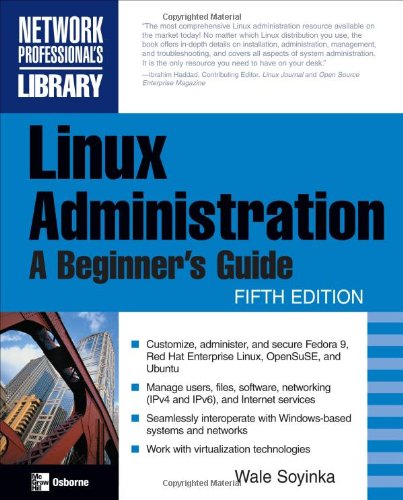
Administer Any Linux Distribution with Ease
Fully updated for the most current Linux distributions, Linux Administration: A Beginner’s Guide, Fifth Edition, shows you how to set up, maintain, and troubleshoot Linux on a single server or an entire network. Get full details on granting user rights and permissions, configuring software and hardware, providing Internet and intranet services, and customizing Linux kernel 2.6. You’ll also learn how to get your network services IPv6 ready, implement sound security, create foolproof system backups, and use the latest virtualization technologies. Real-world, hands-on examples are included throughout.
-
Install and configure popular Linux distributions, including Fedora 9, Red Hat Enterprise Linux, OpenSuSE, and Ubuntu
-
Manage users, permissions, files, folders, and applications
-
Administer Linux servers from the GUI or from the command line (shell)
-
Understand and manage file systems in Linux
-
Compile, tune, and customize Linux kernel 2.6
-
Build robust firewalls and routers using netfilter and Linux
-
Manage the Linux TCP/IP networking stack and services for both IPv4 and IPv6
-
Build and deploy Web, e-mail, and FTP servers
-
Use NIS, NFS, LDAP, and Samba for resource sharing and identity management
-
Set up and administer print, DNS, POP3, IMAP3, and DHCP servers
-
Implement Linux virtualization technologies, including the native KVM platform
Administering a Linux system isn’t much like administering a Windows machine. Though the goals are similar and comparable problems arise under both environments, they each require administrators to adopt a certain way of thinking about processes and data. Linux Administration: A Beginner’s Guide helps readers adapt their Windows experience to Linux work. Author Steve Shah does a great job of clueing Linux newcomers into the environment. His explanations are clear, patient, accurate, and useful, and they cover all aspects of the system administrator’s job. He’s careful to explain hundreds of commands in a logical way, including lists of options and examples of typical uses in many cases.
But this is no mere command reference or novice’s introduction. Shah doesn’t shy away from explaining the really interesting aspects of Linux administration, including kernel compilation, Domain Name Service (DNS) configuration, sendmail setup, and establishing firewall protection with IP chaining. For all of these subjects (and many more), this book includes clear statements of what concepts are relevant, which commands to issue, and what to expect in response. It’s a great help in self-guided explorations. It’s also worth having this book on hand for work assignments–you’ll find complete recipes for configuring all major Internet and local area network (LAN) services that also take into account easy maintenance and security. –David Wall
Topics covered: Administering Linux 2.2.x (particularly Red Hat, Caldera, and SuSE distributions). Installation, initial configuration, using the bash command shell, managing files, managing software, and granting rights to users. DNS, FTP, Apache, sendmail, Samba, and other services receive lots of attention.



